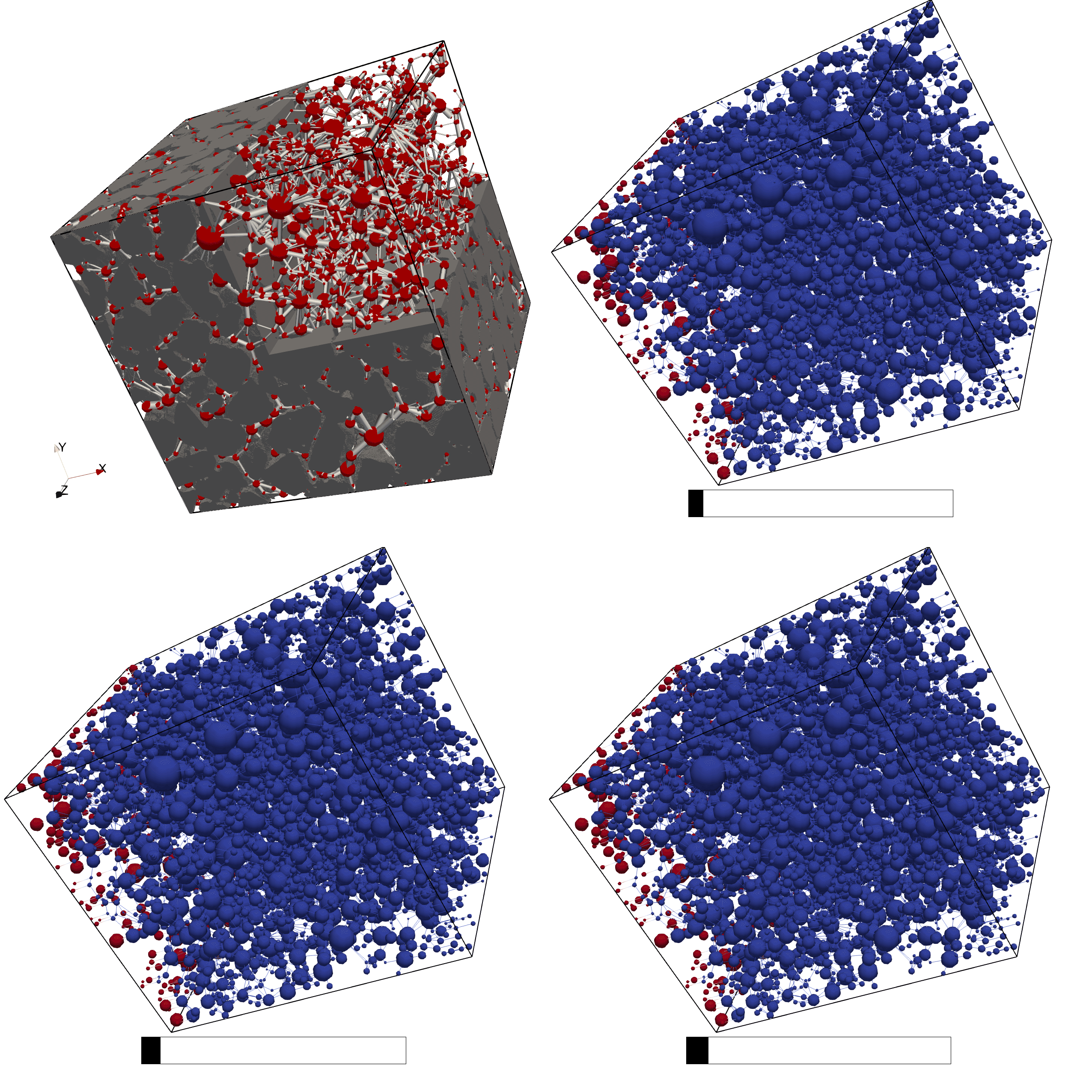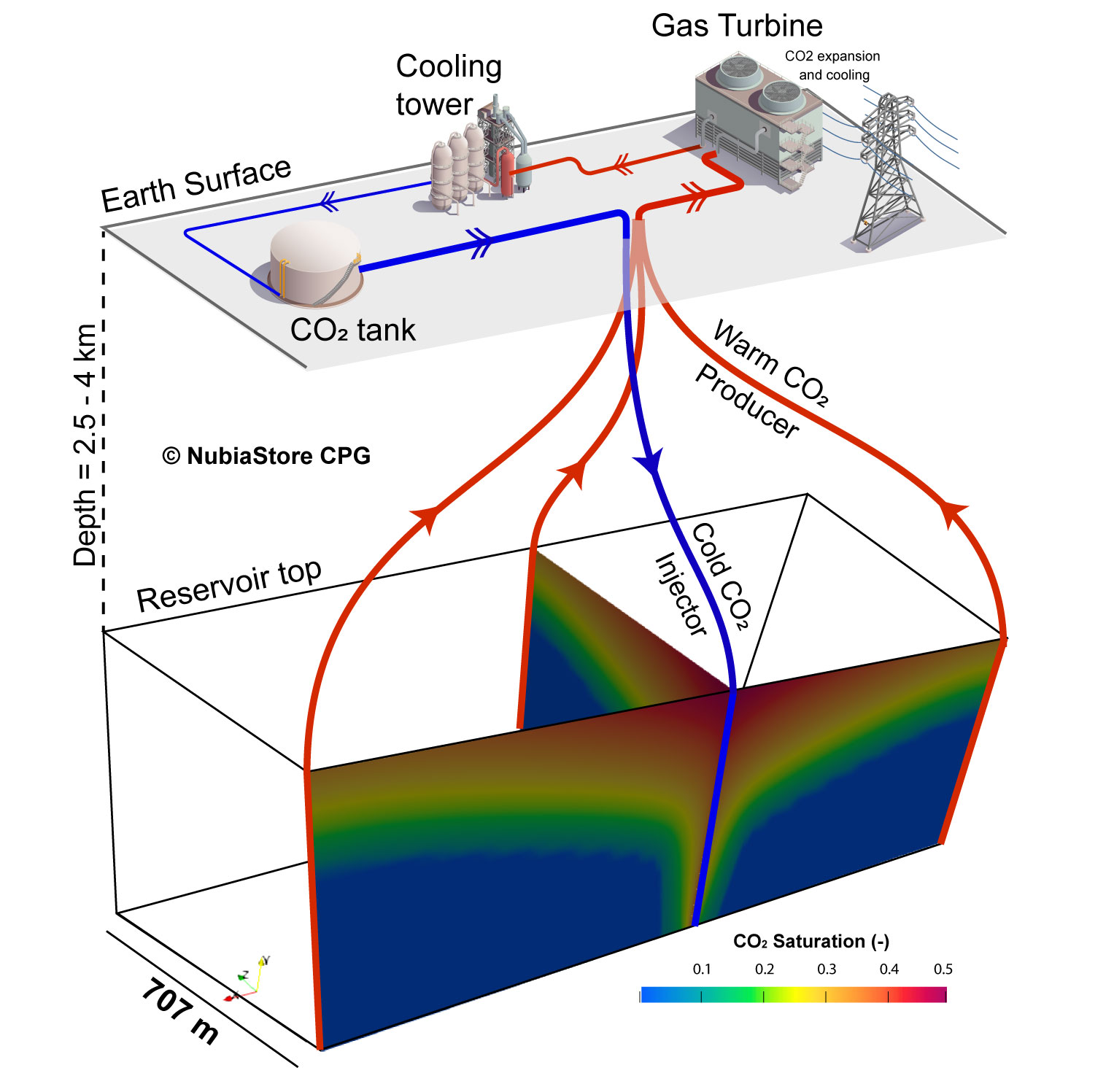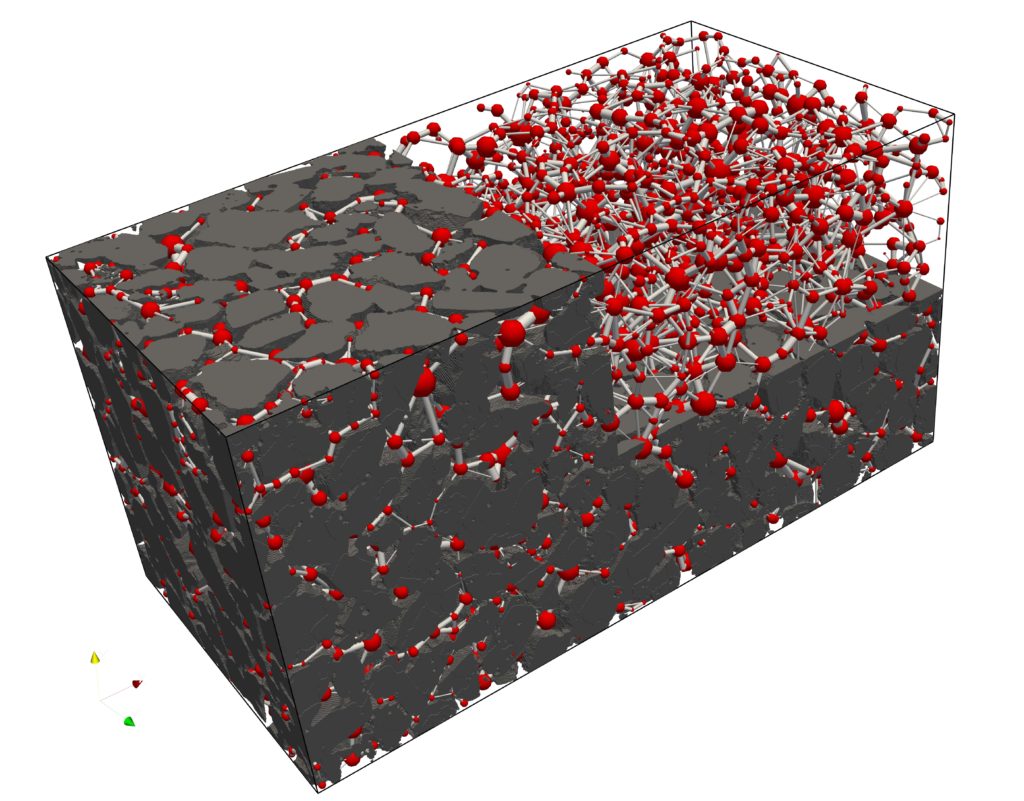Prof. Martin O. Saar, ETH Zurich
Dr. Anozie Ebigbo, ETH Zurich
Mahmoud Hefny, ETH Zurich
Introduction
Depleted oil fields in the Gulf of Suez (Egypt) can serve as geothermal reservoirs for power generation using a CO2-Plume Geothermal (CPG) system, while geologically sequestering CO2. NubiaStore is a research project that entails the injection of a substantial amount of CO2 into the highly permeable brine-saturated Nubian Sandstone at Hamam Faraun Hotspring.
We are developing numerical models of two-phase flow processes for predicting the CO2-plume migration at multiple length scales ranging from the Nano-meter scale using Synchrotron Radiation X‐ray Tomographic Microscopy (SRXTM) to reservoir-scale using the released subsurface field dataset. We are, currently, focusing on employing capillary pressure, relative permeability curves, and pore-scale displacement mechanisms to predict the extent of CO2 plume migration at a representative geological scale.
Pore-Network Modeling
A quasi-static pore-network modelling has been used to simulate the equilibrium positions of fluid-fluid interfaces, and thus determine the capillary pressure and relative permeability curves. Three-dimensional images with a voxel size of 0.65 um2 of a Nubian Sandstone rock sample have been obtained using Synchrotron Radiation X-ray Tomographic Microscopy. From the images, topological properties of pores/throats were constructed. Using a pore-network model, we performed sequential primary drainage–main imbibition cycles of quasi-static invasion in order to quantify (1) the CO2 and brine relative permeability curves, (2) the effect of initial wetting-phase saturation (i.e. the saturation at the point of reversal from drainage to imbibition) on the residual–trapping potential, and (3) study the relative permeability–saturation hysteresis. The results improve our understanding of the potential magnitude of capillary trapping in Nubian Sandstone, essential for future field-scale simulations. Further, an initial basin-scale assessment of CO2 storage capacity, which incorporates capillary trapping, yields a range of 14-49 GtCO2 in Nubian Sandstone, Gulf of Suez Basin.

Pore-Network Modeling: Quasi-static (Drainage and Imbibition) simulations of two-phase (scCO2-Brine) in a natural rock sample (Nubian Sandstone, Egypt) to incorporate the effects of CO2 trapping. © NubiaStore project.
Reservoir simulations
CO2 Plume Geothermal systems (CPG) (Randolph and Saar, 2011a, b; Saar et al., 2012; Buscheck et al., 2013), involve the injection of CO2 that comes from a CO2 emitter, as a working fluid to extract heat and pressure energy (enthalpy) from naturally high-permeability sedimentary or stratigraphic basins. The injected CO2 forms a large subsurface CO2 plume that permanently sequesters CO2 underground and absorbs heat from the geothermal reservoir. The CO2 plume can be “tapped” for thermal and/or electric power production in a geothermal power system (Randolph and Saar, 2011a; Saar et al., 2012; Adams et al., 2014, 2015).

Reservoir simulation of scCO2 injection into a brine-saturated Nubian Sandstone (the Gulf of Suez, Egypt). The CO2 enters the reservoir through a vertical (or deviated) injection well. After moving through the geothermal reservoir, the heated CO2 is produced from deviated production wells. © NubiaStore project.
Related Publications by the GEG Group
REFEREED PUBLICATIONS IN JOURNALS
PROCEEDINGS REFEREED
Other Publications (Journals and Conference Proceeding/Abstracts)
- Hefny M., Ebigbo A., Qin C.-Z., Adam B., and Saar M. O.: NubiaStore: A multidisciplinary investigation for implementing CPG in the Gulf of Suez (Egypt). Maturing Geothermal Energy for Saudi Arabia – Research Conference 2020: 27-29 January in KAUST, Thuwal, Kingdom of Saudi Arabia. [ePoster]
- Qin C.-Z., and Hefny M.: Quantitative Predictions of Two-Phase Flow Dynamics in Porous Media by the Pore-Network Modeling. AGU Fall Meeting 2019: 9-13 December 2019in San Francisco, California, USA. [Abstract]
- Hefny M., Qin C.-Z., Ebigbo A., Gostick J., Saar M. O., and Hammed M.: CO2-Brine flow in Nubian Sandstone, Egypt: A Pore-Network Modeling using Computerized Tomography Imaging. European Geothermal Congress (EGC): 11-14 June 2019 in The Hague, The Netherlands. [Conference Proceeding]
- Qin C.-Z., Hefny M., and van Brummelen, E.H.: Quantitative Predictions of Two-Phase Flow Dynamics in Porous Media by the Pore-Network Modeling. 11 Annual Meeting – InterPore 2019, Minisymposia 9 Pore-scale modelling: 6-10 May 2019 in Valencia, Spain.[Abstract]
- Hefny M., Hammed M., Ebigbo A., and Saar M. O.: Petrophysical characterization of Nubian Sandstone reservoirs and their potential for geothermal applications; central Gulf of Suez, Egypt. 6th European Geothermal Workshop (EGW): 10-11 October 2018 in Strasbourg, France.
References
- Adams, B. M., Kuehn, T. H., Bielicki, J. M., Randolph, J. B., & Saar, M. O. (2014). “On the importance of the thermosiphon effect in CPG (CO2 plume geothermal) power systems.” Energy 69:409-418.
- Adams, B. M., Kuehn, T. H., Bielicki, J. M., Randolph, J. B., & Saar, M. O. (2015). “A comparison of electric power output of CO2 plume geothermal (CPG) and brine geothermal systems for varying reservoir conditions.” Applied Energy 140:365-377.
- Buscheck, T. A., Elliot, T. R., Celia, M. A., Chen, M., Sun, Y., Hao, Y., Lu, C., Wolery, T. J., & Aines, R. D. (2013). “Integrated geothermal-CO2 reservoir systems: Reducing carbon intensity through sustainable energy production and secure CO2 storage.” Energy Procedia 37:6587-6594.
- Dezayes, C., Genter, A., Hooijkaas, G. R. (2005). “Deep-seated geology and fracture system of the EGS Soultz reservoir (France) based on recent 5km depth boreholes.” Proceedings of World Geothermal Congress, Antalya, Turkey.
- Gardes, R. A. (1995). Method of drilling multiple radial wells using multiple string downhole orientation. U.S. Patent No. 5,394,950.
- Gardes, R. A. (1998). Method and system for drilling underbalanced radial wells utilizing a dual string technique in a live well. U.S. Patent No. 5,720,356.
- Noble, J. B. (1992). Directional drilling apparatus and method. U.S. Patent No. 5,113,953.
- Randolph, J.B., & Saar, M. O. (2011a). ” Coupling carbon dioxide sequestration with geothermal energy capture in naturally permeable, porous geologic formations: Implications for CO2 sequestration.” Energy Procedia 4:2206-2213.
- Randolph, J.B., & Saar, M. O. (2011b). “Combining geothermal energy capture with geologic carbon dioxide sequestration.” Geophysical Research Letters 38 (10).
- Saar, M. O., Randolph, J. B., & Kuehn, T. H. (2012). Carbon dioxide-based geothermal energy generation systems and methods related thereto. U.S. Patent No. 8,316,955 (International patents pending).
- Spycher, N., Pruess, K. (2011). “A model for thermophysical properties of CO2-brine mixtures at elevated temperatures and pressures.” Proceedings Thirty-Sixth Workshop on Geothermal Reservoir Engineering, Stanford Geothermal workshop, Stanford, CA.
- Welch, P., Boyle, P. (2009). “New Turbines to Enable Efficient Geothermal Power Plants.” GRC Trans 33:765-772.



